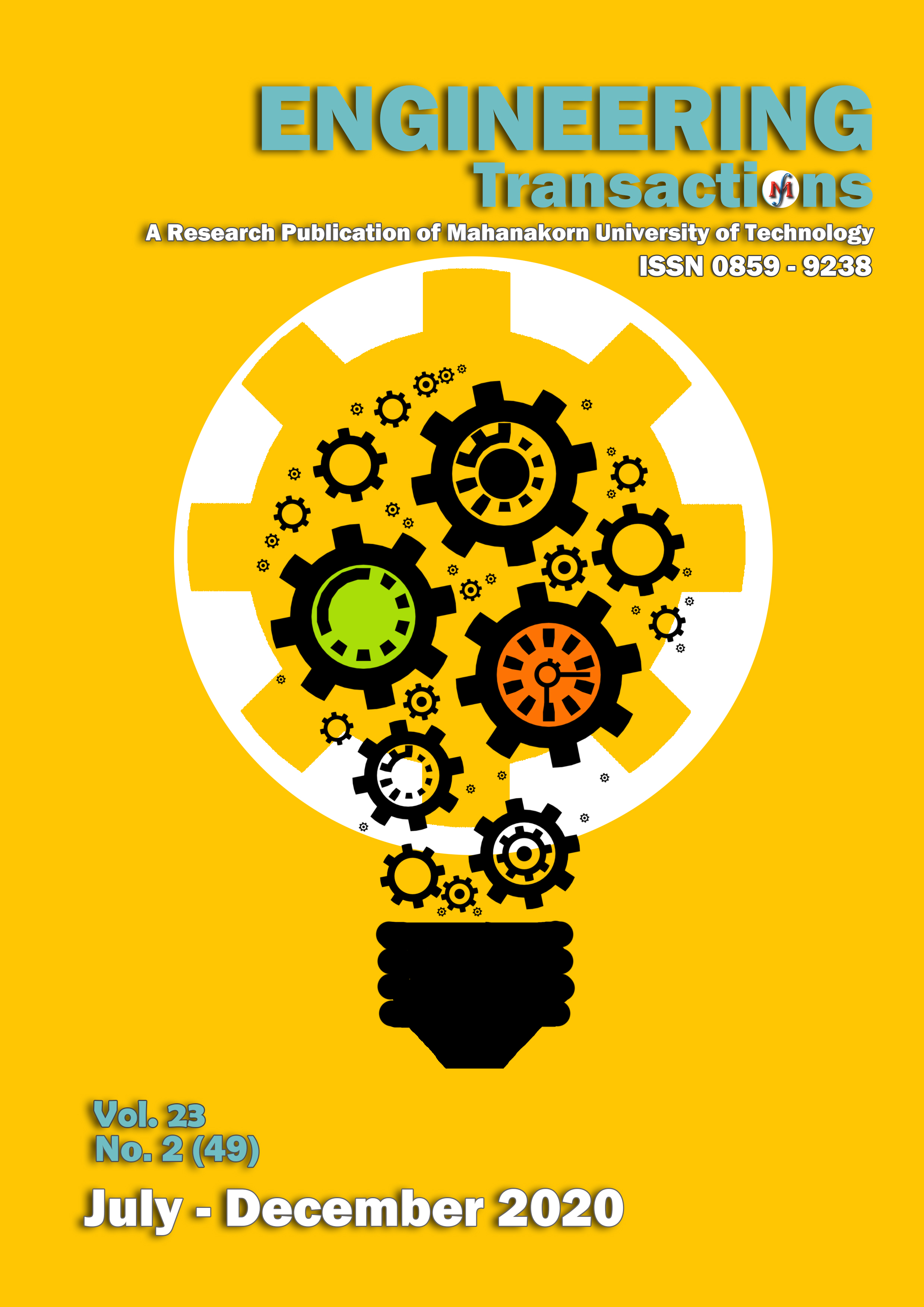Study of Preliminary Estimation of Coronavirus Reproduction Number at the Early Stage of Outbreak
Main Article Content
Abstract
This paper presents the basic concept of coronavirus reproduction number concerning the definition and an important of basic reproduction number and reproduction number. This leads to the knowledge of contagious disease level related to coronavirus disease and lifted lockdown in Thailand. Mathematical equations of preliminary estimation of virus reproduction number at the early stage of outbreak are associated with the contagious virus disease in comparison with the reported laboratory-confirmed cases of coronavirus infections and being lifted lockdown in Thailand. Simulation results show that the preliminary estimation of coronavirus reproduction number is related to the lifted lockdown regarded as the dangerous of coronavirus pandemic in this recent.
Article Details
Copyright @2021 Engineering Transactions
Faculty of Engineering and Technology
Mahanakorn University of Technology
References
World Health Organization. (2020 Jan). "Statement on the second meeting of the International Health Regulations (2005) Emergency Committee regarding the outbreak of novel coronavirus (2019-nCoV)". [Online]. Available: https://www.who.int/news -room/detail/30-01-2020-statement-on-the-second-meeting-of-the-international-health-regulations-(2005)-emergency-committee-regarding-the-outbreak-of-novel-coronavirus-(2019-ncov). [Accessed: May 11, 2020].
Centers for Disease Control and Prevention. (2020 Apr). "What you should know about COVID-19 to protect yourself and others". [Online]. Available: https://www.cdc.gov/co ronavirus/2019-ncov/downloads/2019-ncov-factsheet.pdf. [Accessed: May 11, 2020].
S. Zhao, J. Ran, S. S. Musa, G. Yang, Y. Lou, D. Gao, L. Yang, D. He, "Preliminary estimation of the basic reproduction number of novel coronavirus (2019-nCoV) in China, from 2019 to 2020: A data-driven analysis in the early phase of the outbreak", International Journal of Infectious Diseases, vol. 92, pp. 214–217, 2020.
Z. Zhuanga, S. Zhaob,c, Q. Lind, P. Caoe, Y. Loua, L. Yangf, S. Yang, D. Hea, L. Xiaog, “Preliminary estimates of the reproduction number of the coronavirus disease (COVID-19) outbreak in Republic of Korea and Italy by 5 March 2020”, International Journal of Infectious Diseases, vol. 95, pp. 308–310, 2020.
J. Yuana, M. Lib, G. Lvc, Z. K. Lud, “Monitoring transmissibility and mortality of COVID-19 in Europe”, International Journal of Infectious Diseases, vol. 95, pp. 311–315, 2020.
S. Zhanga, M. Diaob, W. Yuc, L. Peic, Z. Lind, D. Chena, “Estimation of the reproductive number of novel coronavirus (COVID-19) and the probable outbreak size on the Diamond Princess Cruise ship: A data-driven analysis”, International Journal of Infectious Diseases, vol. 93, pp. 201–204, 2020.
Y. Ochoa, D. E. Sáncheza, M. Rallóna, H. F. Mottaa, Y. R. Fandiñoa, “Effective Repro- ductive Number estimation for initial stage of COVID-19 pandemic in Latin American Countries”, International Journal of Infectious Diseases, vol. 95, pp. 316–318, 2020.
A. E. Gorbalenya, S. C. Baker, R. S. Baric, et al. “The Species Severe Acute Respiratory Syndrome-related Coronavirus: Classifying 2019-nCoV and naming it SARS-CoV-2”, Nature Microbiology, vol. 5, pp. 536–544, 2020.
Department of Microbiology, Faculty of Medicine Siriraj Hospital, Mahidol University. “Novel coronavirus 2019 (2019-nCoV)”. [Online]. Available: https://www.si.mahidol. ac.th/th/healthdetail.asp?aid=1410. [Access- ed: 10 May 2020].
Q. Li, X. Guan, P. Wu, X. Wang. "Early Transmission Dynamics in Wuhan, China, of Novel Coronavirus-Infected Pneumonia", New England Journal of Medicine, vol. 383, no. 13, pp. 1199-1207, Jan. 2020.
World Health Organization. “Naming the coronavirus disease (COVID-19) and the virus that causes it”. [Online]. Available: https://www.who.int/emergencies/diseases/novel-coronavirus-2019/technical-guidance/ naming-the-coronavirus-disease-(covid-2019)-and-the-virus-that-causes-it. [Accessed: 10 May 2020].
K. J. Rothman, S. Greenland, T. L. Lash, “Modern Epidemiology”, 3rd Edition, Lippincott Williams & Wilkins, 2008.
World Health Organization. “Novel coronavirus-2019”. [Online]. Available: https://www.who.int/thailand/emergencies/novel-coronavirus-2019. [Accessed May 10 2020].
“Epidemic theory”. [Online]. Available: https://www.healthknowledge.org.uk/public-health-textbook/ research-methods/1a-epide miology/epidemic-theory. [Accessed 10 May 2020].
F. M. Guerra, S. Bolotin, G. Lim, J. Heffernan, S. Deeks, L. Shelley, Y. Li, N. Crowcroft. "The Basic Reproduction Number (R0) of Measles: A Systematic Review", The Lancet Infectious Diseases, vol. 17, no. 12, pp. e420–e428, 2017.
P. E. Fine, “Herd Immunity: history, theory, practice”, Epidemiologic Reviews, vol. 15, pp. 265-302, 1993.
C. Freeman, "Magic formula that will determine whether Ebola is beaten". [Online]. Available: https://www.telegraph.co.uk/news /worldnews/ebola/11213280/Magic-formula-that-will-determine-whether-Ebola-is-beaten. html. [Accessed: May 10, 2020].
B.J. Coburn, B. G. Wagner, S. Blower. "Modeling influenza epidemics and pandemics: insights into the future of swine flu (H1N1)", BMC Medicine, vol. 7, Article 30, 2009.
A. Khan, M. Naveed, M. Ahmad, M. Imran, “Estimating the basic reproductive ratio for the Ebola outbreak in Liberia and Sierra Leone”, Infectious Diseases of Poverty, vol. 4, no. 13, Feb. 2015.
N.M. Ferguson, D.A. Cummings, C. Fraser, J.C. Cajka, P. C. Cooley, D.S. Burke, “Strategies for Mitigating an Influenza Pandemic”, Nature, vol. 442, no. 7101, pp. 448–452, 2006.
A. Kucharski, C.L. Althaus, “The Role of Superspreading in Middle East Respiratory Syndrome Coronavirus (MERS-CoV) Transmission”, Eurosurveillance, vol. 20, no. 26, pp. 14 – 18, 2015.
S. Sanche, Y. T. Lin, C. Xu, E. Severson, N. Hengartner, R. Ke, “High Contagiousness and Rapid Spread of Severe Acute Respiratory Syndrome Coronavirus 2”, Emerging Infectious Diseases, vol. 26, no. 7, Apr. 2020.
Z. Cao, Q. Zhang, X. Lu, D. Pfeiffer, Z. Jia, H. Song, D. D. Zeng, “Estimating the effective reproduction number of the 2019-nCoV in China”, medRxiv, 2020.
F. Brauer F, “Compartmental Models in Epidemiology”, in F. Brauer, P. van den Driessche, J. Wu (eds), Mathematical Epidemiology, Lecture Notes in Mathematics, vol. 1945. Springer, Berlin, Heidelberg, 2008.
Y. Liu, A. A. Gayle, A. Smith, J. Rocklov, “The Reproductive number of COVID-19 is higher compared to SARS coronavirus”, Journal of Travel Medicine, pp. 1–4, 2020.
Department of Disease Control, Ministry of Public Health, Thailand. “Covid-19 Infected Situation Reports”. [Online]. Available: https://covid19.ddc.moph.go.th/. [Accessed 10 May 2020].
G. N. Milligan, A. D. T. Barrett, Vaccinology : An Essential Guide, Wiley Blackwell, 2015.


